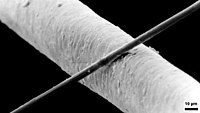
Photo from wikipedia
Abstract Poor interlaminar fracture toughness is a critical limitation in the performance of fiber reinforced polymer matrix composites over a wide range of structural applications. Recent efforts to overcome this… Click to show full abstract
Abstract Poor interlaminar fracture toughness is a critical limitation in the performance of fiber reinforced polymer matrix composites over a wide range of structural applications. Recent efforts to overcome this problem have shown that the introduction of various forms of nanoscale interleaves can yield composites with improved toughness. In this work, it is demonstrated that forests of vertically aligned, laser induced graphene (LIG) can provide significant improvement to the interlaminar properties of carbon fiber reinforced composites. The conductive graphene interlayers are first synthesized using a laser induction process and then transfer printed onto carbon fiber prepregs while maintaining their out-of-plane alignment. The introduced LIG interlayers result in a significantly increased short beam shear toughness, along with a 41% and 69% increase in both initiation Mode I and pre-cracked Mode II fracture toughness of the composites, respectively. In addition, the tensile and viscoelastic properties of the carbon fiber composites are preserved post-treatment. The LIG strengthened interlaminar region exhibit failure modes that provide greater resistance to crack initiation and propagation such as cohesive failure, crack deflection and nanoscale bridging. Therefore, this work provides a simple, fast and convenient method to toughen carbon fiber reinforced composites using transferred LIG interlayers, allowing for the cost-effective and rapid fabrication of simultaneously strong and tough carbon fiber reinforced composite structures.
Journal Title: Composites Science and Technology
Year Published: 2021
Link to full text (if available)
Share on Social Media: Sign Up to like & get
recommendations!